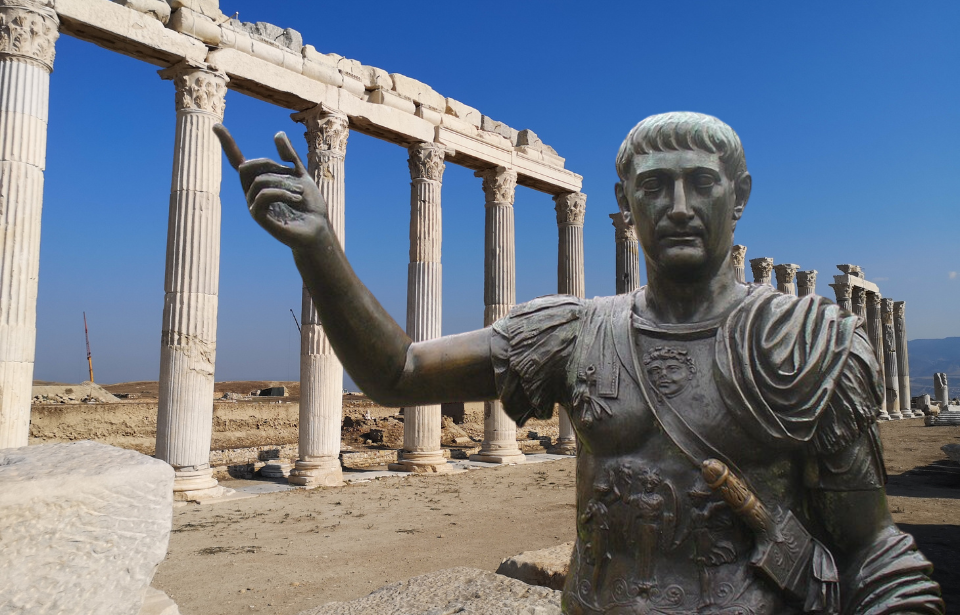Laodicea on the Lycus, sometimes written as Laodikeia or Laodiceia, was an ancient city located on the river Lycus in what is now Turkey. The city was founded by Antiochus II Theos, king of the Seleucid Empire, between 261 and 253 BC. Later, under Roman control, Laodicea became the capital of a Roman conventus consisting of 25 cities.
The remnants of Laodicea that can be seen today are from the Roman period, and they present a large, impressive, and affluent city toward the edge of the Roman Empire.
Origins of the city
The earliest settlements in the region date to the Late Chalcolithic and Early Bronze Age periods (3500 to 3000 BC). The town of Diospolis, meaning the ‘City of Zeus’ and later called Rhodas, existed on the site during the 4th century BC. Archaeological excavations have shown that these settlements were founded by populations native to Asia Minor.
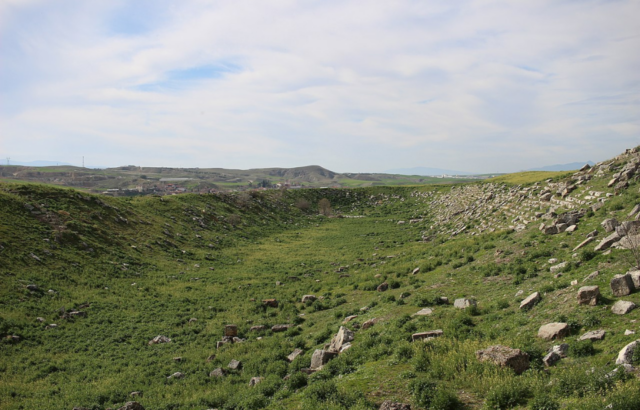
Laodicea was founded in the mid-third century BC by Antiochus II Theos, king of the Seleucid Empire. The city was named after the king’s wife, Laodice. During the reign of Antiochus III the Great, 2,000 Jewish families were brought to the Phrygia area from Babylon. The population of Laodicea from this period onward was largely Jewish.
The wealth of the community and Laodicea itself was so great that nine kilograms of gold were sent to the Temple in Jerusalem each year. This Jewish population was later the basis of a Christian community in Laodicea.
Roman Laodicea
At the Battle of Magnesia, which took place in either December 190 or January 189 BC, the Romans defeated the Seleucids. Following the battle, control of the region was given to the Kingdom of Pergamon. Following the death of its final king in 133 BC, the kingdom was given to Rome. While the city had suffered during the Mithridatic Wars, under Roman control, the city quickly began to flourish.
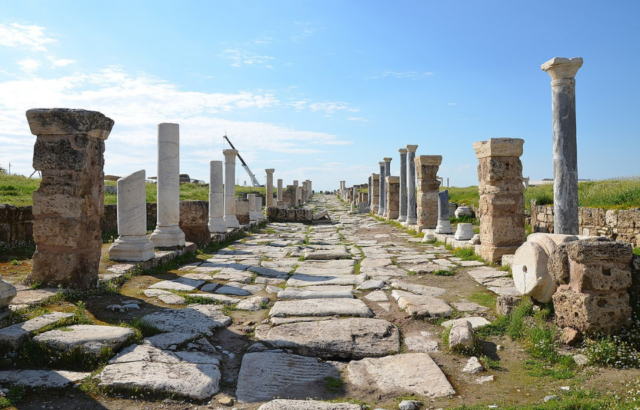
Laodicea greatly benefitted from Rome’s influence and trade routes. The city came to be an important place for traders and was well known for its production of textiles, including tunics called trimata, which led to the city being called Trimataria. Laodicea was also the site of marble, cattle, and grain trading. The vast wealth of the city was even referred to in the Bible.
The city was destroyed by earthquakes and rebuilt multiple times. One of the worst of these was in 27 BC during the reign of Augustus. Another struck in 60 AD, and when Emperor Nero offered money for the reconstruction, the citizens of Laodicea rejected it and paid for the reconstruction themselves. Laodicea was the only city in the province to not accept Nero’s assistance.
The Romans made Laodicea into the chief city of a conventus, which was a subdivision within a Roman province.
Remnants of Laodicea
The remnants of Laodicea are a testament to the size and greatness of the city. Temples, baths, a stadium, gymnasium, assembly house, agora, and two theaters are proof of a once-flourishing city. The Ephesus gate, along with streets, colonnades, and pedestals, are seen across the city. Outside the boundaries of the city, there is a bridge over the Asopos River, as well as many sarcophagi and an aqueduct.
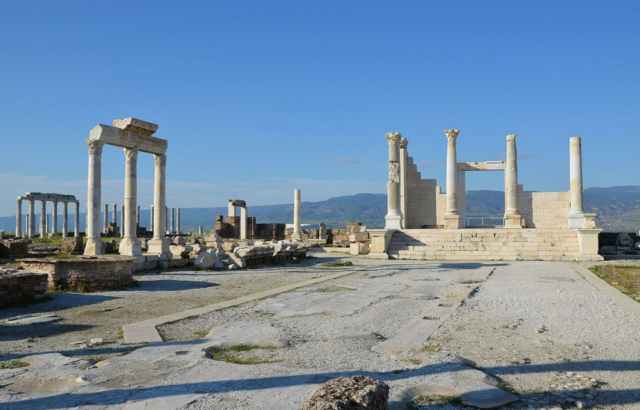
The aqueduct runs for several kilometers from the Baspinar Spring in Denizli and might have extended further. Unlike typical Roman aqueducts which carried water high above the city, this one at Laodicea used an inverted siphon consisting of a double pressurized pipeline, going down into the valley and back up into the city. Remains of the aqueduct’s support arches can be seen east of the stadium and the South Baths.
An earthquake destroyed the aqueduct, and the remaining arches are at an extreme angle.
In 2015, a marble block was discovered with the inscription of a water law. In 114 AD, this law was issued to regulate the use of water imported to Laodicea from the mountains with penalties of five to 12.5 thousand denarii for polluting water, destroying channels, or opening water pipes.
Restoration work
The site has seen some restorations. The central agora has been slightly restored, with many of its 10.8-meter tall columns being raised back up. The Agora also features a 100-meter-long and 11-meter-tall wall which is covered with frescoes. In 2022, the West Theatre was restored. It was constructed during the Hellenistic period and had seating for 8000 spectators. It was used at Laodicea until the 7th century AD.
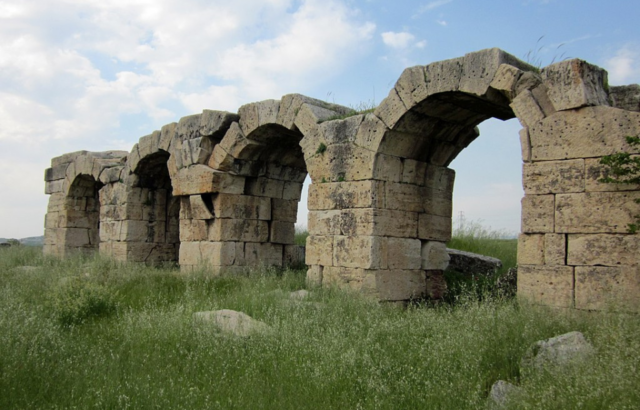
The stadium is located at the southernmost point of the city. Built within a narrow valley that’s closed on both ends, it took advantage of the natural landscape, adding marble seating on the sides. At the western end of the stadium is a subterranean passage. Horses and chariots would have used this to enter and exit the stadium.
North of the stadium is a gymnasium and twin baths. These are linked to the south agora as well as the bouleuterion, which has an inscription that shows Emperor Hadrian’s visit in 135 AD.
Discovery of a statue of Trajan
In 2019, archaeologists working at Laodicea discovered hundreds of pieces of a statue beneath a water fountain. They reconstructed a large statue of Trajan, Roman Emperor from 98 until 117 AD, who helped expand the Empire’s borders to their greatest extent.
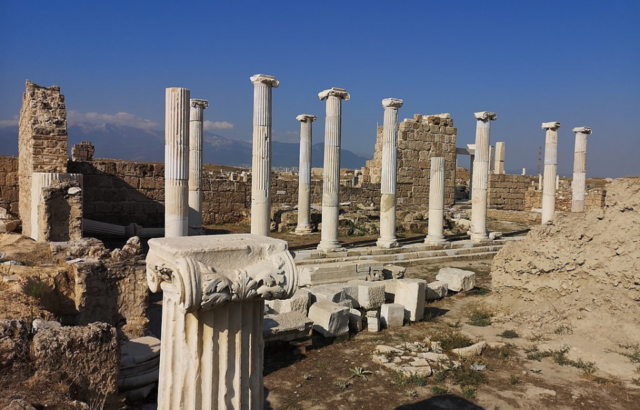
The statue is 1,906 years old and stands three meters tall. Trajan is seen in full military uniform, including decorated body armor, a tunic, and a cape hanging from his left shoulder and draped over his left arm.
Trajan’s weight is placed on his right foot as his left foot is slightly raised. His right arm is raised in a standard pose of a Roman orator, suggesting that he is addressing a crowd. The statue bears a striking resemblance to the Augustus of Prima Porta, which depicts the first emperor, Augustus Caesar.
Tribute to Trajan
On his right, an enemy is down on one knee with his hands tied behind his back. The prisoner wears a Phrygian cap, which suggests that he is from the province of Phrygia, the region where Laodicea is located. The juxtaposition between the Emperor and the prisoner shows a victorious Trajan concurring territory and people represented by the cowering enemy.
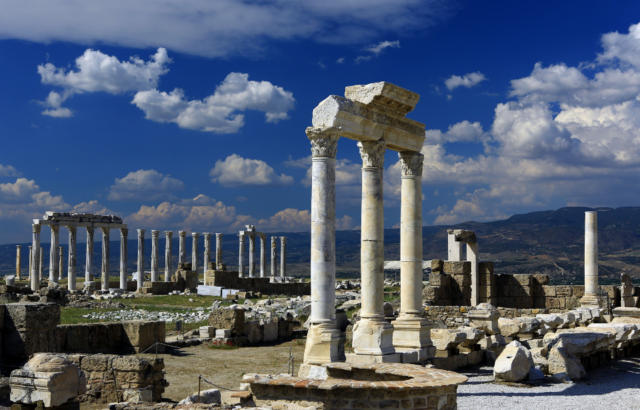
Researchers have determined that the statue of Trajan was completed in 113 AD. It is believed that an earthquake caused the statue to break into 356 pieces, which were later buried beneath the fountain. As reported by Hurriyet Daily News, Trajan constructed a waterway in Laodicea in addition to providing it with great wealth, so the statue was a way of honoring the Emperor for helping the city.
More from us: Have Archaeologists Found the Temple of Hercules Gaditanus?
Professor Celal Şimşek, who led the excavations, told Hurriyet Daily News that the discovery was of unusually good quality, which allowed researchers to see how detailed and intricate the statue is. He also reported that due to the precision of Trajan’s face, the sculptor likely saw the emperor in person. Trajan’s cuirass is also extremely detailed, depicting the thunder of Jupiter, Medusa, two griffons, and Apollo.
